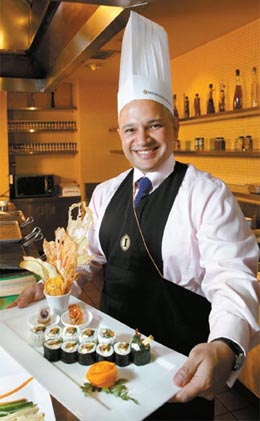For Aussie chamber chief, business is all wrapped up in gimbap

Sean Rodrigues, chairman of the Australian Chamber of Commerce in Korea, says gimbap can be compared to business, with each ingredient having a role to play. By Oh Sang-min
“When any French person goes out of Paris for a picnic, they take with them a baguette and cheese,” Rodrigues said. “Koreans take rice rolls.”
And he knows what he’s talking about - when he went on his first picnic here after his arrival in 1999, Rodrigues carried rolls of gimbap stuffed with various ingredients including spinach and bulgogi (marinated beef), just as his Korean friends had taught him.
“I went for a picnic with my friends to Cheongpyeong Lake [in Gapyeong, Gyeonggi],” he said. “And since you can’t go anywhere without food, my friends came to my apartment and one of the dishes we made together was gimbap. It was the easiest first dish that I was taught how to make, which is why I always remember.”
And that’s why the dish is special to him, even though gimbap is not Rodrigues’ favorite Korean food, because “it is snack food - very simple and easy to eat,” it is certainly up toward the top of the list. His favorite Korean dish is actually the spicy nakji bokkeum (stir-fried octopus) or chueotang (traditional loach soup) because they “keep you warm during the winter season.”
What is appealing about gimbap, Rodrigues said, is the rich flavor that results from the combination of ingredients.
And the idea of mixing individual elements to build a satisfying whole is similar to the business he promotes in Korea as chief representative of Woodside Energy, Australia’s largest oil and gas company. The firm is engaged in three business sectors in Korea - construction, exploration and selling oil and gas.
“Each of the ingredients used in making gimbap has a role to play, which is also important in business, for example, the construction business with shipyards,” Rodrigues said. “Our engineers and designers need to be involved but Korea is providing the hardware and software to them. It brings together two different things to create something new that neither side can do independently.”
Woodside Energy has had many projects with Samsung Heavy Industries on Geoje Island, South Gyeongsang, and with Hyundai Heavy Industries in Ulsan.
“Even today, Hyundai is building for us a very large offshore platform for Australia, which is going to be one of the largest in the world,” he said.
As for the exploration business, Woodside Energy is the only company that has a joint venture with the Korea National Oil Corporation to explore the East Sea.
After our interview, chef Kim Jae-sun of the Grand InterContinental Seoul walked over and handed Rodrigues a chef’s hat and apron before taking him to the open kitchen of the hotel’s C-Grill restaurant. Rodrigues greeted him cheerfully and seemed eager to demonstrate his culinary skills.
The two started by cutting carrots, cucumbers and other vegetables into long, thin slices before sauteing them in a lightly oiled pan. Once the vegetables were fried, the chef helped Rodrigues marinate minced Australian beef in a sauce made with soy sauce, sesame seeds, garlic and pepper.
As he was mixing the beef and sauce, Rodrigues talked about the ongoing negotiations for a free trade agreement between Korea and Australia. The two countries have held five rounds of formal discussions on the matter so far. The Australian prime minister, treasurer and trade minister even visited Korea in November to talk about the pact.
“One of the things Australia likes to market is its beef,” Rodrigues said. “People say the sensitive part of the FTA is in the agricultural area but that’s not really true.
“The imported beef market in Korea is about 40 percent but Korean beef consumption is increasing,” he said.
That’s good news for the Australian beef industry, he added, because if the beef market expands, then the market for imported beef will also grow. Although Australian beef could be considered a threat to Korean beef, Rodrigues believes that the main competition will be among beef importers and not between importers and hanwoo, Korean beef.
“We don’t want to compete with hanwoo. We want to compete with imports,” he said, while placing sticky rice on a sheet of seaweed.
Rodrigues then began to put each of the ingredients he prepared with chef Kim - carrots, cucumbers, pickled radish, burdock root, beef, spinach and egg - on top of the rice before rolling it up and slicing it into pieces.
Sean Rodrigues
*Chairman, Australian Chamber of Commerce in Korea
*Chief representative (Korea), Woodside Energy
*2003: Joined Woodside Energy
*1993-2002: Various positions in the Australian Dept. of Foreign Affairs and Trade
* Graduated from the University of Western Australia with a bachelor’s and master’s degree in economics
By Lee Eun-joo [angie@joongang.co.kr]










with the Korea JoongAng Daily
To write comments, please log in to one of the accounts.
Standards Board Policy (0/250자)